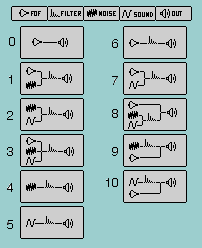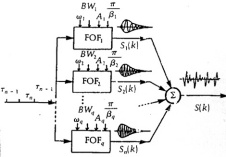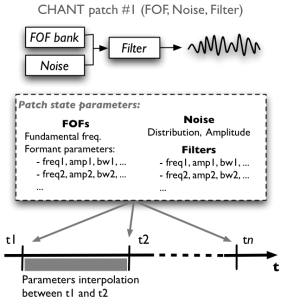Principles
Chant "Patches"
The Chant synthesiser is initialised by the connexion of several synthesis or processing modules : FOF banks (a set of FOF generators), Filter banks (a set of resonant filters), Noise generator, and sound file player. In the current implementation, 11 configurations (or "patches") are available. Chant can therefore perform FOF synthesis, but also, for instance, filter an input sound with a resonant filter, add a controlled noise source and merge different configurations of these options (provided the corresponding patch is available among the 11 options). |  The 11 different configurations (or "patches") of the Chant synthesizer. |
Control Procedure
Chant is controlled via SDIF files (Sound Description Interchange Format) where the state of the synthesis modules are specified at different times (with a free and non-regular rate). The synthesizer interpolates between these states in order to compute the output sound at the final sample rate. See the Chant/SDIF specification for more detail about the SDIF specification for the control of Chant : http://recherche.ircam.fr/anasyn/sdif/SdifNormDoc.html Basically, the different tools in OM-Chant will allow to generate this sequence of control frames formatted as an SDIF file, and use this file in a call to the synthesizer. Two different control approaches are available with OM-Chant :
|
FOF Synthesis
The FOF synthesizer in Chant consists in a number of parallel FOF generators, all driven by a common impulse train. FOFs are small sinusoidal grains modulated by a precisely shaped envelope. A train of such grains contributes to the resulting spectrum with a formant, whose central frequency, amplitude, shape and bandwidth can be precisley controlled. Typically, 5 FOF generators are used to synthesize voice sounds. The frequency of the pusle train determines the fundamental frequency (or "f0")of the resulting sound. All the parameters of the FOFs, as well as the global fundamental frequency, are subject to continuous change during the synthesis process. |  FOF synthesis (image from Rodet et al., 1985). |
In Chant the fundamental frequency (f0) and the FOFs are controlled individually, although they are clasely related in the synthesis process.
The different control tools in OM-Chant will therefore assume that both F0 and FOF data are systematically provied.

